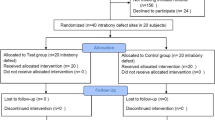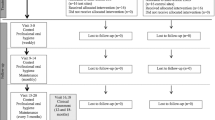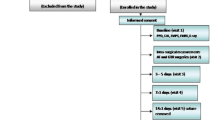Abstract
The purpose of the present randomized controlled clinical study was to compare the clinical outcomes of papilla preservation flap surgery with or without the application of a novel nanocrystalline hydroxyapatite (nano-HA) bone graft substitute. Fourteen patients with paired intrabony periodontal defects of ≥4 mm participated in this split-mouth design study. The defects in each subject were randomly selected to receive nano-HA paste in conjunction with papilla preservation flaps or papilla preservation flaps alone. Probing bone levels (PBL) from a customized acrylic stent and probing pocket depths (PPD) were measured at baseline and again 6 months following surgery. No differences in any of the investigated parameters were observed at baseline between the two groups. Healing was uneventful in all patients. Both treatments resulted in significant improvements between baseline and 6 months (p < 0.05). At 6 months after therapy, the sites treated with nano-HA paste showed a reduction in mean PPD from 8.3 ± 1.2 to 4.0 ± 1.1 mm and a gain in PBL of 4.3 ± 1.4 mm, whereas in the control group, the mean PPD changed from 7.9 ± 1.2 mm to 5.0 ± 1.2 mm and PBL gain was 2.6 ± 1.4 mm. Results demonstrated statistically greater PPD reduction and PBL gain (p < 0.05) in the test group as compared with the control group. In conclusion, after 6 months, the treatment of intrabony periodontal defects with a nano-HA paste leads to significantly improved clinical outcomes when compared with papilla preservation flap surgery alone.


Similar content being viewed by others
References
Cortellini P, Tonetti MS (2000) Focus on intrabony defects: guided tissue regeneration. Periodontol 2000 22:104–132
Hiatt WH, Schallhorn RG (1973) Intraoral transplants of cancellous bone and marrow in periodontal lesions. J Periodontol 44:194–208
Lekovic V, Kenney EB, Carranza FA, Danilovic V (1990) Treatment of class II furcation defects using porous hydroxyapatite in conjunction with a polytetrafluoroethylene membrane. J Periodontol 61:575–578
Lynch SE, de Castilla GR, Williams RC, Kiritsy CP, Howell TH, Reddy MS, Antoniades HN (1991) The effects of short-term application of a combination of platelet-derived and insulin-like growth factors on periodontal wound healing. J Periodontol 62:458–467
McClain PK, Schallhorn RG (1993) Long term assessment of combined osseous composite grafting, root conditioning, and guided tissue regeneration. Int J Periodontics Restorative Dent 13:9–27
Mellonig JT, Bowers GM, Cotton WR (1981) Comparison of bone graft materials. J Periodontol 52:297–301
Froum SJ, Kushner L, Scopp IW, Stahl SS (1982) Human clinical and histologic responses to Durapatite implants in intraosseous lesions. Case reports. J Periodontol 53:719–725
Baldock WT, Hutchens LH Jr, McFall WT Jr, Simpson DM (1985) An evaluation of tricalcium phosphate implants in human periodontal osseous defects of two patients. J Periodontol 56:1–7
Tamai N, Myoui A, Tomita T, Nakase T, Tanaka J, Ochi T, Yoshikawa H (2002) Novel hydroxyapatite ceramics with an interconnective porous structure exhibit superior osteoconduction in vivo. J Biomed Mater Res 59:110–117
Hing KA, Best SM, Tanner KE, Bonfield W, Revell PA (1997) Biomechanical assessment of bone ingrowth in porous hydroxyapatite. J Mater Sci Mater Med 8:731–736
Meffert RM, Thomas JR, Hamilton KM, Brownstein CN (1985) Hydroxylapatite as an alloplastic graft in the treatment of human periodontal osseous defects. J Periodontol 56:63–73
Moskow BS, Lubarr A (1983) Histological assessment of human periodontal defect after durapatite ceramic implant. Report of a case. J Periodontol 54:455–462
Bezrukov VM, Grigor’iants LA, Zuev VP, Pankratov AS (1998) The surgical treatment of jaw cysts using hydroxyapatite with an ultrahigh degree of dispersity. Stomatologiia (Mosk) 77:31–35
Thorwarth M, Schultze-Mosgau S, Kessler P, Wiltfang J, Schlegel KA (2005) Bone regeneration in osseous defects using a resorbable nanoparticular hydroxyapatite. J Oral Maxillofac Surg 63:1626–1633
Huber FX, Mcarthur N, Hillmeier J, Kock HJ, Baier M, Diwo M, Berger I, Meeder PJ (2006) Void filling of tibia compression fracture zones using a novel resorbable nanocrystalline hydroxyapatite paste in combination with a hydroxyapatite ceramic core: first clinical results. Arch Orthop Trauma Surg 126:533–540
Grigor’ian AS, Grigor’iants LA, Podoinikova MN (2000) A comparative analysis of the efficacy of different types of filling materials in the surgical elimination of tooth perforations (experimental morphological research). Stomatologiia (Mosk) 79:9–12
Gerlach KL, Niehues D (2007) Treatment of jaw cysts with a new kind of nanoparticular hydroxylapatite. Mund Kiefer Gesichtschir 11:131–137
Schwarz F, Bieling K, Latz T, Nuesry E, Becker J (2006) Healing of intrabony peri-implantitis defects following application of a nanocyrstalline hydroxyapatite (Ostim™) or a bovine-derived xenograft (Bio-Oss™) in combination with a collagen membrane (Bio-Gide™). A case series. J Clin Periodontol 33:491–499
Kasaj A, Röhrig B, Zafiropoulos GG, Willershausen B (2008) Clinical evaluation of nanocrystalline hydroxyapatite paste in the treatment of human periodontal bony defects—a randomized controlled clinical trial: 6-month results. J Periodontol 79:394–400
Zuev VP, Dmitrieva LA, Pankratov AS, Filatova NA (1996) The comparative characteristics of stimulators of reparative osteogenesis in the treatment of periodontal diseases. Stomatologiia (Mosk) 75:31–34
Cortellini P, Pini Prato GP, Tonetti M (1999) The simplified papilla preservation flap. A novel surgical approach for the management of soft tissues in regenerative procedures. Int J Periodontics Restorative Dent 19:589–599
Cortellini P, Pini Prato GP, Tonetti M (1995) The modified papilla preservation technique. A new surgical approach for interproximal regenerative procedures. J Periodontol 66:217–223
Hujoel PP, Moulton LH (1988) Evaluation of test statistics in split-mouth clinical trials. J Periodontal Res 23:378–380
Needleman I, Tucker R, Giedrys-Leeper E, Worthington H (2005) Guided tissue regeneration for periodontal intrabony defects—a cochrane systematic review. Periodontol 37:106–123
Jeffcoat M, Jeffcoat RL, Jens SC, Captain K (1986) A new periodontal probe with automated cemento-enamel junction design. J Clin Periodontol 13:276–280
Persson GR (1991) Effects of line-angle versus midproximal periodontal probing measurements on prevalence estimates of periodontal disease. J Periodontal Res 26:527–529
Zybutz M, Rapoport D, Laurell L, Persson GR (2000) Comparisons of clinical and radiographic measurements of inter-proximal vertical defects before and 1 year after surgical treatments. J Clin Periodontol 27:179–186
Wachtel H, Schenk G, Böhm S, Weng D, Zuhr O, Hürzeler MB (2003) Microsurgical access flap and enamel matrix derivative for the treatment of periodontal intrabony defects: a controlled clinical study. J Clin Periodontol 30:496–504
Trombelli L, Bottega S, Zucchelli G (2002) Supracrestal soft tissue preservation with enamel matrix proteins in the treatment of deep intrabony defects. A report of 35 consecutively treated cases. J Clin Periodontol 29:433–439
Kasaj A, Willershausen B, Reichert C, Gortan-Kasaj A, Zafiropoulos GG, Schmidt M (2008) Human periodontal fibroblast response to a nanostructured hydroxyapatite bone replacement graft in vitro. Arch Oral Biol 53:683–689
Reynolds MA, Aichelmann-Reidy ME, Branch-Mays GL, Gunsolley JC (2003) The efficacy of bone replacement grafts in the treatment of periodontal osseous defects. A systematic review. Ann Periodontol 8:227–265
Kenney EB, Lekovic V, Han T, Carranza FA Jr, Dimitrijevic B (1985) The use of porous hydroxylapatite (HA) implant in periodontal defects. I. Clinical results after six months. J Periodontol 56:82–88
Trombelli L, Heitz-Mayfield L, Needleman I, Moles D, Scabbia A (2002) A systematic review of graft materials and biological agents for periodontal intraosseous defects. J Clin Periodontol 29:117–135
Stahl SS, Froum SJ (1987) Histologic and clinical responses to porous hydroxylapatite implants in human periodontal defects. Three to twelve months postimplantation. J Periodontol 58:689–695
Bauer TW, Muschler GF (2000) Bone graft materials. An overview of the basic science. Clin Orthop Relat Res 371:10–27
Horvath A, Stavropoulos A, Sculean A (2009) Clinical and histological evaluation of human intrabony periodontal defects treated with an unsintered nanocrystalline hydroxyapatite paste (Ostim®). J Clin Periodontol 36:116
Sun W, Chu C, Wang J, Zhao H (2007) Comparison of periodontal ligament cells responses to dense and nanophase hydroxyapatite. J Mater Sci Mater Med 18:677–683
Schnettler R, Dingeldein E (2002) Inorganic bone substitutes. In: Lewandrowski KU, Wise DL, Trantolo DJ, Gresser JD, Yaszemski MJ, Altobelli DE (eds) Tissue engineering and biodegradable equivalents: scientific and clinical applications. Marcell Dekker, Inc., New York, pp 401–432
Chris Arts JJ, Verdonschot N, Schreurs BW, Buma P (2006) The use of a bioresorbable nano-crystalline hydroxyapatite paste in acetabular bone impaction grafting. Biomaterials 27:1110–1118
Schnettler R, Stahl JP, Alt V, Pavlidis T, Dingeldein E, Wenisch S (2004) Calcium phosphate-based bone substitutes. Eur J Trauma 4:219–229
Conflict of interest
The authors declare that they have no conflict of interest.
Author information
Authors and Affiliations
Corresponding author
Rights and permissions
About this article
Cite this article
Heinz, B., Kasaj, A., Teich, M. et al. Clinical effects of nanocrystalline hydroxyapatite paste in the treatment of intrabony periodontal defects: a randomized controlled clinical study. Clin Oral Invest 14, 525–531 (2010). https://doi.org/10.1007/s00784-009-0325-x
Received:
Accepted:
Published:
Issue Date:
DOI: https://doi.org/10.1007/s00784-009-0325-x




